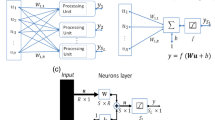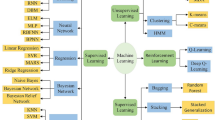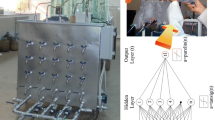Abstract
Computational self-adapting methods (Support Vector Machines, SVM) are compared with an analytical method in effluent composition prediction of a two-stage anaerobic digestion (AD) process. Experimental data for the AD of poultry manure were used. The analytical method considers the protein as the only source of ammonia production in AD after degradation. Total ammonia nitrogen (TAN), total solids (TS), chemical oxygen demand (COD), and total volatile solids (TVS) were measured in the influent and effluent of the process. The TAN concentration in the effluent was predicted, this being the most inhibiting and polluting compound in AD. Despite the limited data available, the SVM-based model outperformed the analytical method for the TAN prediction, achieving a relative average error of 15.2% against 43% for the analytical method. Moreover, SVM showed higher prediction accuracy in comparison with Artificial Neural Networks. This result reveals the future promise of SVM for prediction in non-linear and dynamic AD processes.

ᅟ






Similar content being viewed by others
Change history
07 January 2019
The original publication of this paper contains a mistake. Unfortunately, an author was inadvertently missed out, Constanza Arriagada had participated in the operation of the anaerobic digesters cited in the work and now as a PhD student, she is involved in the production of other publication
07 January 2019
The original publication of this paper contains a mistake. Unfortunately, an author was inadvertently missed out, Constanza Arriagada had participated in the operation of the anaerobic digesters cited in the work and now as a PhD student, she is involved in the production of other publication
References
Abbasi M, Abduli MA, Omidvar B, Baghvand A (2012) Forecasting municipal solid waste generation by hybrid support vector machine and partial least square model. Int J Environ Res 7:27–38
Abouelenien F, Namba Y, Kosseva MR, Nishio N, Nakashimada Y (2014) Enhancement of methane production from co-digestion of chicken manure with agricultural wastes. Bioresour Technol 159:80–87. https://doi.org/10.1016/j.biortech.2014.02.050
Alejo-Alvarez L, Guzmán-Fierro V, Fernández K, Roeckel M (2016) Technical and economical optimization of a full-scale poultry manure treatment process: total ammonia nitrogen balance. Environ Technol 28. https://doi.org/10.1080/09593330.2016.1167963
Angelidaki I, Ellegaard L, Ahring BK (1993) A mathematical model for dynamic simulation of anaerobic digestion of complex substrates: focusing on ammonia inhibition. Biotechnol Bioeng 42:159–166. https://doi.org/10.1002/bit.260420203
Angelidaki I, Ellegaard L, Ahring BK (1999) A comprehensive model of anaerobic bioconversion of complex substrates to biogas. Biotechnol Bioeng 63:363–372. https://doi.org/10.1002/(SICI)1097-0290(19990505)63:3<363::AID-BIT13>3.0.CO;2-Z
Awolusi OO, Nasr M, Kumari S, Bux F (2016) Artificial intelligence for the evaluation of operational parameters influencing nitrification and nitrifiers in an activated sludge process. Microb Ecol 72:49–63. https://doi.org/10.1007/s00248-016-0739-3
Batstone DJ, Keller J, Angelidaki I, Kalyuzhnyi SV, Pavlostathis SG, Rozzi A, Sanders WT, Siegrist H, Vavilin VA (2002) The IWA anaerobic digestion model no 1 (ADM1). Water Sci Technol 45:65–73
Batstone DJ, Puyol D, Flores-Alsina X, Rodríguez J (2015) Mathematical modelling of anaerobic digestion processes: applications and future needs. Rev Environ Sci Biotechnol 14:595–613. https://doi.org/10.1007/s11157-015-9376-4
Bergland W, Botheju D, Dinamarca C, Bakke R (2011) Considering culture adaptations to high ammonia concentration in ADM1. SIMS 2011 52nd Int. Conf. Scand. Simul. Soc. 1, 1–8
Blumensaat F, Keller J (2005) Modelling of two-stage anaerobic digestion using the IWA anaerobic digestion model no. 1 (ADM1). Water Res 39:171–183. https://doi.org/10.1016/j.watres.2004.07.024
Boisen S, Bech-Andersen S, Eggum BO (1987) A critical view on the conversion factor 6.25 from total nitrogen to protein. Acta Agric Scand 37:299–304. https://doi.org/10.1080/00015128709436560
Borowski S, Domański J, Weatherley L (2014) Anaerobic co-digestion of swine and poultry manure with municipal sewage sludge. Waste Manag 34:513–521. https://doi.org/10.1016/j.wasman.2013.10.022
Breure AM, Mooijman KA, van Andel JG (1986) Protein degradation in anaerobic digestion: influence of volatile fatty acids and carbohydrates on hydrolysis and acidogenic fermentation of gelatin. Appl Microbiol Biotechnol 24:426–431. https://doi.org/10.1007/BF00294602
Browne MW (2000) Cross-validation methods. J Math Psychol 44:108–132. https://doi.org/10.1006/jmps.1999.1279
Bujoczek G, Oleszkiewicz J, Sparling R, Cenkowski S (2000) High solid anaerobic digestion of chicken manure. J Agric Eng Res 76:51–60. https://doi.org/10.1006/jaer.2000.0529
Cao H, Xin Y, Yuan Q (2016) Prediction of biochar yield from cattle manure pyrolysis via least squares support vector machine intelligent approach. Bioresour Technol 202:158–164. https://doi.org/10.1016/j.biortech.2015.12.024
Chang R, College W (2002) Quimica General, 7th ed. McGraw-Hill
Corominas L, Garrido-Baserba M, Villez K, Olsson G, Cortés U, Poch M (2017) Transforming data into knowledge for improved wastewater treatment operation: a critical review of techniques. Environ Model Softw. https://doi.org/10.1016/j.envsoft.2017.11.023
Cortes C, Vapnik V (1995) Support-vector networks. Mach Learn 20:273–297. https://doi.org/10.1023/A:1022627411411
Dellana SA, West D (2009) Predictive modeling for wastewater applications: linear and nonlinear approaches. Environ Model Softw 24:96–106. https://doi.org/10.1016/j.envsoft.2008.06.002
Dixon M, Gallop JR, Lambert SC, Healy JV (2007) Experience with data mining for the anaerobic wastewater treatment process. Environ Model Softw 22:315–322. https://doi.org/10.1016/j.envsoft.2005.07.031
Donoso-Bravo A, Mailier J, Martin C, Rodríguez J, Aceves-Lara CA, Wouwer AV (2011) Model selection, identification and validation in anaerobic digestion: a review. Water Res 45:5347–5364. https://doi.org/10.1016/j.watres.2011.08.059
Erdirencelebi D, Yalpir S (2011) Adaptive network fuzzy inference system modeling for the input selection and prediction of anaerobic digestion effluent quality. Appl Math Model 35:3821–3832. https://doi.org/10.1016/j.apm.2011.02.015
Gavala HN, Angelidaki I, Ahring BK (2003) Kinetics and modeling of anaerobic digestion process. Biomethanation I 81:57–93. https://doi.org/10.1007/3-540-45838-7
Ghaly AE, Macdonald KN (2012) Drying of poultry manure for use as animal feed. Am J Agric Biol Sci 7:239–254. https://doi.org/10.3844/ajabssp.2012.239.254
Guo H, Jeong K, Lim J, Jo J, Kim YM, Park J, Kim JH, Cho KH (2015) Prediction of effluent concentration in a wastewater treatment plant using machine learning models. J Environ Sci 32:1–12. https://doi.org/10.1016/j.jes.2015.01.007
Hall M, Frank E, Holmes G, Pfahringer B, Reutemann P, Witten IH (2009). The WEKA data mining software: an update. ACM SIGKDD Explor. Newsl 11:10–18. https://doi.org/10.1145/1656274.1656278
Hansen KH, Angelidaki I, Ahring BK (1998) Anaerobic digestion of swine manure inhibition by ammonia. Water Sci Technol 32:5–12
Holm-Nielsen JB, Al Seadi T, Oleskowicz-Popiel P (2009) The future of anaerobic digestion and biogas utilization. Bioresour Technol 100:5478–5484. https://doi.org/10.1016/j.biortech.2008.12.046
Iyappan P, Karthikeyan S, Sekar S (2011) Changes in the composition of poultry farm excreta (PFE) by the cumulative influence of the age of birds, feed and climatic conditions and a simple mean for minimizing the environmental hazard. Int J Environ Sci 1:847–859
Kelleher BP, Leahy JJ, Henihan AM, O’Dwyer TF, Sutton D, Leahy MJ (2002) Advances in poultry litter disposal technology—a review. Bioresour Technol 83:27–36. https://doi.org/10.1016/S0960-8524(01)00133-X
Kleerebezem R, van Loosdrecht MCM (2006) Critical analysis of some concepts proposed in ADM1. Water Sci Technol 54:51–57. https://doi.org/10.2166/wst.2006.525
Kuhn, M., 2008. Building predictive models in R using the caret package. J Stat Softw 28. https://doi.org/10.18637/jss.v028.i05
Lancaster HO, Seneta E (2005) Chi-square distribution, in: Encyclopedia of biostatistics. John Wiley & Sons, Ltd. https://doi.org/10.1002/0470011815.b2a15018
Lauwers J, Appels L, Thompson IP, Degrève J, Van Impe JF, Dewil R (2013) Mathematical modelling of anaerobic digestion of biomass and waste: power and limitations. Prog Energy Combust Sci 39:383–402. https://doi.org/10.1016/j.pecs.2013.03.003
Mosquera-Corral A, Sánchez M, Campos JL, Méndez R, Lema JM (2001) Simultaneous methanogenesis and denitrification of pretreated effluents from a fish canning industry. Water Res 35:411–418. https://doi.org/10.1016/S0043-1354(00)00288-8
Powers W, Capelari M (2017) Production, management and the environment symposium: measurement and mitigation of reactive nitrogen species from swine and poultry production. J Anim Sci 95:2236–2240. https://doi.org/10.2527/jas2016.1187
R Foundation for Statistical Computing (2016) R: a language and environment for statistical computing. R Core Team, Vienna
Ramsay IR, Pullammanappallil PC (2001) Protein degradation during anaerobic wastewater treatment: derivation of stoichiometry. Biodegradation 12:247–257. https://doi.org/10.1023/A:1013116728817
Rashid R, Jamaluddin H, Aishah N, Amin S (2016) Empirical and feed forward neural networks models of tapioca starch. Appl Artif Intell 20:9514–9597. https://doi.org/10.1080/08839510500191422
Rivera-Salvador V, Aranda-Barradas JS, Espinosa-Solares T, Robles-Martínez F, Toledo JU (2015) The anaerobic digestion model Iwa-Adm1: a review of its evolution. Ing Agríc Biosist 1:109–117. https://doi.org/10.5154/r.inagbi.2010.01.001
Roshani A, Shayegan J, Babaee A (2012) Methane production from anaerobic co-digestion of poultry manure. J Environ Stud 38:22–24
Samanta B, Al-Balushi KR, Al-Araimi SA (2003) Artificial neural networks and support vector machines with genetic algorithm for bearing fault detection. Eng Appl Artif Intell 16:657–665. https://doi.org/10.1016/j.engappai.2003.09.006
Siegrist H, Vogt D, Garcia-Heras JL, Gujer W (2002) Mathematical model for meso- and thermophilic anaerobic sewage sludge digestion. Environ Sci Technol 36:1113–1123. https://doi.org/10.1021/es010139p
Smola AJ, Scholkopf B (2004) A tutorial on support vector regression. Stat Comput 14:199–222. https://doi.org/10.1023/B:Stco.0000035301.49549.88
Strik DPBTB, Domnanovich AM, Zani L, Braun R, Holubar P (2005) Prediction of trace compounds in biogas from anaerobic digestion using the MATLAB neural network toolbox. Environ Model Softw 20:803–810. https://doi.org/10.1016/j.envsoft.2004.09.006
Turkdogan-Aydinol FI, Yetilmezsoy K (2010) A fuzzy-logic-based model to predict biogas and methane production rates in a pilot-scale mesophilic UASB reactor treating molasses wastewater. J Hazard Mater 182:460–471. https://doi.org/10.1016/j.jhazmat.2010.06.054
Üstün B, Melssen WJ, Buydens LMC (2006) Facilitating the application of support vector regression by using a universal Pearson VII function based kernel. Chemom Intell Lab Syst 81:29–40. https://doi.org/10.1016/j.chemolab.2005.09.003
Vanhooren H, Meirlaen J, Amerlinck Y, Claeys F, Vangheluwe H, Vanrolleghem PA (2003) WEST: modelling biological wastewater treatment. J Hydroinf 27–50
Yenigün O, Demirel B (2013) Ammonia inhibition in anaerobic digestion: a review. Process Biochem 48:901–911. https://doi.org/10.1016/j.procbio.2013.04.012
Yu L, Wensel P, Ma J, Chen S (2013) Mathematical modeling in anaerobic digestion (AD). J Biorem Biodegrad S4, 12. https://doi.org/10.4172/2155-6199.S4-003
Acknowledgments
This research was conducted with the FONDECYT (Chile) No. 1140491, INNOVA (Chile) No. 12IDL2-13605, CONICYT-PCHA/Doctorado Nacional2016/21160226 and INNOVA (Chile) No 15VEIID-45613 grants.
Author information
Authors and Affiliations
Corresponding author
Additional information
Responsible editor: Bingcai Pan
Appendix
Appendix
Rights and permissions
About this article
Cite this article
Alejo, L., Atkinson, J., Guzmán-Fierro, V. et al. Effluent composition prediction of a two-stage anaerobic digestion process: machine learning and stoichiometry techniques. Environ Sci Pollut Res 25, 21149–21163 (2018). https://doi.org/10.1007/s11356-018-2224-7
Received:
Accepted:
Published:
Issue Date:
DOI: https://doi.org/10.1007/s11356-018-2224-7




